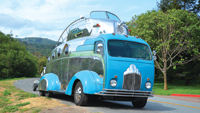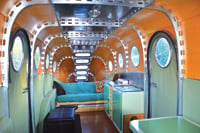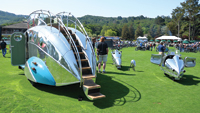 The photos that are on our cover this month and accompany this column show a 1973 GMC motorhome, according to the vehicle’s registration. But it doesn’t look like a 40-year-old GMC motorhome, you say. Well, it’s been modified.
The photos that are on our cover this month and accompany this column show a 1973 GMC motorhome, according to the vehicle’s registration. But it doesn’t look like a 40-year-old GMC motorhome, you say. Well, it’s been modified.
Called the Decoliner, it is the creation of automotive artist Randy Grubb of Grants Pass, Oregon. He took a 1973 GMC motorhome chassis, added the stylishly round front of a 1950 White 3000 COE truck cab and fabricated an aluminum and glass body to make it a work of art. It’s not your daddy’s motorhome unless your daddy was Flash Gordon.
Grubb was a highly successful maker of artistic glass pieces a dozen years ago when he decided to veer in another direction, building on his lifelong interest in hot rods. He grew up in Glendale, California, the son of a dentist who was an automotive enthusiast. Randy was just 12 when he started tearing down and rebuilding cars.
He went to college to study dentistry, but an arts course in glass blowing led him to a career in glass art. His creations became so prized that he could sell a glass paperweight for $12,000. But he wasn’t content to continue making glass art; he was still a hot rodder at heart. So he took metal-shaping classes, worked with a friend on building a roadster and began conceptualizing an automotive art project. His plan wasn’t to modify or replicate a classic vehicle, but to create something entirely new, something so outrageous that Jay Leno would buy it.
Grubb started with an 1800-cubic-inch V-12 engine from an M47 Patton tank, and created a car called the Blastolene Special, named for a group of artists who encourage each other’s efforts. The project took a year of full-time work and a very supportive wife, Grubb said, since the family bank account kept dwindling, dropping down to $1,000.
Grubb didn’t know Jay Leno or have a way of contacting the talk show host and car collector, but he took the Blastolene Special to the Grand National Roadster Show in Southern California; Leno heard about the vehicle from a friend, and before long Grubb got a phone call from Leno. The vehicle is now in Leno’s collection as the Tank Car.
Vehicles for Art That sale to Leno kicked off a string of projects in which Grubb has transformed scooters, motorcycles, racecars and a motorhome into rolling sculptures he calls automotive art. His pattern is to build something, sell it and move onto something else. He takes commissions, but insists on creative freedom. He doesn’t want to deal with a buyer who might have strong ideas of his own or might suggest ways to make something faster or cheaper.
That sale to Leno kicked off a string of projects in which Grubb has transformed scooters, motorcycles, racecars and a motorhome into rolling sculptures he calls automotive art. His pattern is to build something, sell it and move onto something else. He takes commissions, but insists on creative freedom. He doesn’t want to deal with a buyer who might have strong ideas of his own or might suggest ways to make something faster or cheaper.
Grubb, 52, works slowly and carefully. The Decoliner required 18 months and 5,000 man-hours. His vision was to build something Flash Gordon would have liked in the 1950s—futuristic but rooted in that era. He also wanted to include an idea he picked up during a houseboat vacation—a flying bridge. The result is a motorhome that can either be driven from inside like any motorhome or from the roof, accessed by a convenient exterior stairway.
Because this would be a tall motorhome, Grubb needed a particular chassis. He chose the old GMC because it had front-wheel drive and the floor would be only 14 inches off the ground. That enabled Grubb to build a nice interior, and a platform on top for the driver and passengers to safely sail under highway bridges.
He wound up with a 26-foot aluminum-clad motorhome that at 7,500 pounds is much lighter than the original 1973 GMC. It is powered by an Olds 455 engine. Grubb, with the help of Applied GMC in Northern California, updated the chassis where he could, but he looked to the 1940-50s art deco style for the interior. The Decoliner has portholes for windows, cork flooring, birch doors and furnishings in the popular colors of the day. There is no bathroom or stove, and, unlike other motorhomes, it has entry doors on both sides. Grubb said he put in two doors because he figured the vehicle would wind up in the hands of someone who would use it as a promotional vehicle, and people would be streaming in and out.
Crowd Pleaser As it turned out, Grubb sold the Decoliner in July to a buyer in Michigan who is primarily interested in taking it to car shows.
As it turned out, Grubb sold the Decoliner in July to a buyer in Michigan who is primarily interested in taking it to car shows.
Before selling the Decoliner, Grubb drove it to events all around the West, putting 15,000 miles on it. Everywhere he went, Grubb said, people would stop and ask him about this strange vehicle with stairs leading to the flying bridge. A stop in a gas station would take 45 minutes to an hour.
The reaction, he said, was quite a contrast to the reception he received for Piss’d off Pete, an angry-looking vehicle that Grubb fashioned from a 1960 Peterbilt truck. Some people found the truck scary, Grubb said, while the Decoliner elicited nothing but smiles. As Grubb put it, the gas mileage on the Decoliner isn’t bad, but what’s really good are “the smiles per gallon.”
What’s next for this automotive sculptor?
He’s got scooter and car projects under way, and wouldn’t mind doing another motorhome. But he’s always looking for something new, and was intrigued by a visit to the wooden boat show at Lake Tahoe. “At some point,” he said, “I’m going to build a yacht.”
You can learn more about Grubb’s beautifully sculpted vehicles at randygrubb.com. You can also see his creations and the work that goes into them by watching “Randy Grubb’s Garage,” a series of videos produced by Randy Johnson and available on youtube.com.
Write to Mike Ward, editor at RV Life magazine, 18717 76th Avenue West, Suite B, Lynnwood, WA 98037 or e-mail editor@rvlife.com. Find First Glance online at rvlife.com.

Leave a Reply